雅思写作模板.pdf
雅思英语作文字帖电子版可打印

雅思英语作文字帖电子版可打印Preparing for the IELTS Exam: A Step-by-Step Guide to SuccessEmbarking on the journey to take the IELTS exam can be a daunting prospect, but with the right preparation and mindset, you can achieve your desired score and open doors to new opportunities. The IELTS exam, which stands for the International English Language Testing System, is a widely recognized assessment of English proficiency used for various purposes, such as academic admission, immigration, and professional certification. In this comprehensive guide, we will explore the key strategies and resources to help you excel in the IELTS exam.Understanding the IELTS Exam StructureThe IELTS exam consists of four sections: Listening, Reading, Writing, and Speaking. Each section is designed to assess a specific aspect of your English language skills. The Listening and Speaking sections are the same for both the Academic and General Training modules, while the Reading and Writing sections differ between the two. It is crucial to familiarize yourself with the format and requirements of each section to develop a targeted approach to your preparation.Developing a Comprehensive Study PlanEffective preparation for the IELTS exam requires a well-structured study plan. Begin by assessing your current English proficiency level and identifying your strengths and weaknesses. This will help you create a personalized study plan that focuses on areas that need the most improvement. Allocate sufficient time for each section of the exam, and ensure that you cover all the necessary skills, such as vocabulary, grammar, and task-specific strategies.Mastering the Listening SectionThe Listening section of the IELTS exam tests your ability to understand spoken English in a variety of contexts. To excel in this section, practice actively listening to authentic English audio materials, such as podcasts, news broadcasts, and academic lectures. Familiarize yourself with the different types of questions and strategies for effectively managing your time during the exam.Conquering the Reading SectionThe Reading section assesses your ability to comprehend written texts from various sources. Develop your reading comprehension skills by regularly reading a wide range of materials, including academic articles, newspapers, and magazines. Practice identifying key information, understanding the main ideas, and answering different types of questions, such as multiple-choice, true/false, and short-answer.Mastering the Writing SectionThe Writing section requires you to demonstrate your ability to produce well-structured and coherent written responses. Familiarize yourself with the task types, such as the academic essay and the task 1 report, and practice writing under timed conditions. Pay attention to the task requirements, organize your ideas effectively, and focus on improving your grammar, vocabulary, and cohesion.Excelling in the Speaking SectionThe Speaking section evaluates your ability to communicate effectively in English. Practice speaking English as often as possible, whether with a language partner, in a study group, or by recording yourself and analyzing your performance. Focus on improving your fluency, pronunciation, vocabulary, and the ability to respond to a variety of topics and questions.Utilizing Effective Resources and Practice MaterialsTo supplement your study plan, take advantage of a wide range of resources and practice materials. Utilize IELTS-specific textbooks, online practice tests, and video tutorials to familiarize yourself with the exam format and develop effective strategies. Additionally, consider enrolling in an IELTS preparation course or working with a tutor to receive personalized feedback and guidance.Developing a Positive Mindset and Test-Taking Strategies Approaching the IELTS exam with the right mindset can greatly impact your performance. Cultivate a positive and confident attitude, and practice effective stress management techniques to manage any anxiety or nerves during the exam. Additionally, familiarize yourself with the test-taking strategies, such as time management, effective reading and listening techniques, and strategies for the writing and speaking sections.Continuous Practice and FeedbackConsistent practice and feedback are crucial for improving your English proficiency and IELTS performance. Regularly practice sample questions and tests, and seek feedback from teachers, tutors, or language exchange partners to identify areas for improvement. Analyze your mistakes, learn from them, and continuously refine your skills.ConclusionPreparing for the IELTS exam requires a comprehensive and strategic approach. By understanding the exam structure, developing a personalized study plan, mastering the individual sections, and utilizing effective resources and strategies, you can increase your chances of achieving your desired IELTS score. Remember, the journey to success is not a sprint, but a marathon, and withdedication, persistence, and a positive mindset, you can unlock new opportunities and reach your goals.。
雅思纸笔作文试卷模板
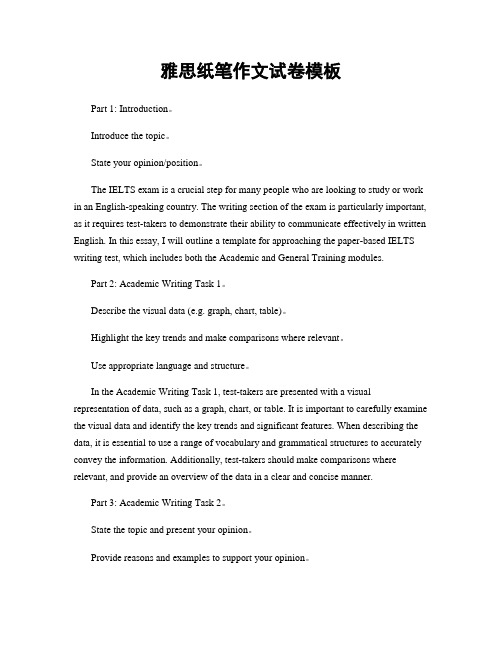
雅思纸笔作文试卷模板Part 1: Introduction。
Introduce the topic。
State your opinion/position。
The IELTS exam is a crucial step for many people who are looking to study or work in an English-speaking country. The writing section of the exam is particularly important, as it requires test-takers to demonstrate their ability to communicate effectively in written English. In this essay, I will outline a template for approaching the paper-based IELTS writing test, which includes both the Academic and General Training modules.Part 2: Academic Writing Task 1。
Describe the visual data (e.g. graph, chart, table)。
Highlight the key trends and make comparisons where relevant。
Use appropriate language and structure。
In the Academic Writing Task 1, test-takers are presented with a visual representation of data, such as a graph, chart, or table. It is important to carefully examine the visual data and identify the key trends and significant features. When describing the data, it is essential to use a range of vocabulary and grammatical structures to accurately convey the information. Additionally, test-takers should make comparisons where relevant, and provide an overview of the data in a clear and concise manner.Part 3: Academic Writing Task 2。
雅思英语作文及模板
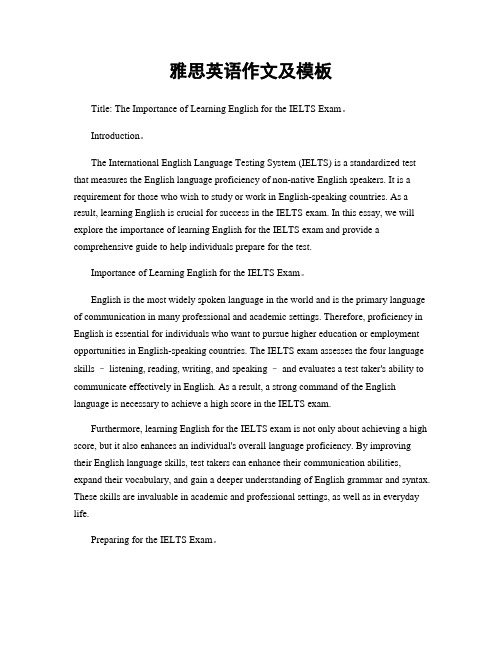
雅思英语作文及模板Title: The Importance of Learning English for the IELTS Exam。
Introduction。
The International English Language Testing System (IELTS) is a standardized test that measures the English language proficiency of non-native English speakers. It is a requirement for those who wish to study or work in English-speaking countries. As a result, learning English is crucial for success in the IELTS exam. In this essay, we will explore the importance of learning English for the IELTS exam and provide a comprehensive guide to help individuals prepare for the test.Importance of Learning English for the IELTS Exam。
English is the most widely spoken language in the world and is the primary language of communication in many professional and academic settings. Therefore, proficiency in English is essential for individuals who want to pursue higher education or employment opportunities in English-speaking countries. The IELTS exam assesses the four language skills – listening, reading, writing, and speaking – and evaluates a test taker's ability to communicate effectively in English. As a result, a strong command of the English language is necessary to achieve a high score in the IELTS exam.Furthermore, learning English for the IELTS exam is not only about achieving a high score, but it also enhances an individual's overall language proficiency. By improving their English language skills, test takers can enhance their communication abilities, expand their vocabulary, and gain a deeper understanding of English grammar and syntax. These skills are invaluable in academic and professional settings, as well as in everyday life.Preparing for the IELTS Exam。
雅思英文写作模板
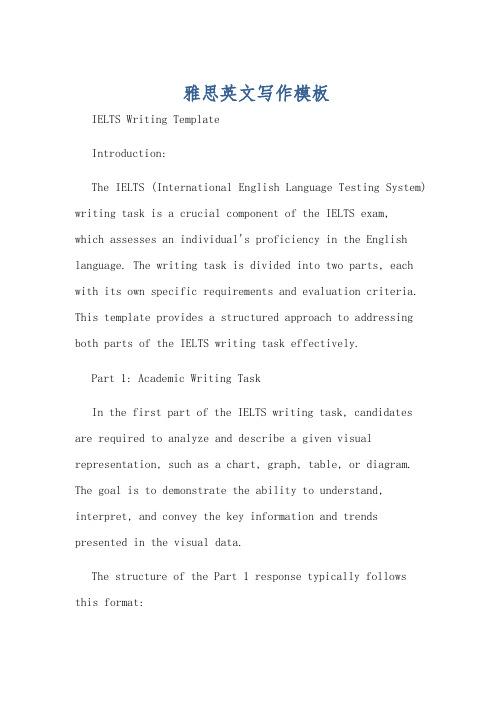
雅思英文写作模板IELTS Writing TemplateIntroduction:The IELTS (International English Language Testing System) writing task is a crucial component of the IELTS exam,which assesses an individual's proficiency in the English language. The writing task is divided into two parts, each with its own specific requirements and evaluation criteria. This template provides a structured approach to addressing both parts of the IELTS writing task effectively.Part 1: Academic Writing TaskIn the first part of the IELTS writing task, candidates are required to analyze and describe a given visual representation, such as a chart, graph, table, or diagram. The goal is to demonstrate the ability to understand, interpret, and convey the key information and trends presented in the visual data.The structure of the Part 1 response typically follows this format:1. Introduction: Begin with a clear and concise overview of the visual representation, stating the main purpose, the type of data presented, and the key features or trends observed.2. Description of the data: Provide a detailed analysis of the visual data, highlighting the significant information, trends, and relationships. Use appropriate vocabulary and grammar to describe the data accurately and objectively.3. Comparison and analysis: Compare and analyze the different elements or components of the visual data, identifying any significant patterns, changes, or differences over time or between different categories.4. Summary and conclusion: Conclude the response by summarizing the main points and providing an overall assessment or interpretation of the visual data.Part 2: General Training Writing TaskThe second part of the IELTS writing task requires candidates to respond to a given prompt or task. This could be a discussion of a particular issue, a proposal orrecommendation, or a personal opinion on a topic. The goal is to demonstrate the ability to organize ideas, present arguments, and communicate effectively in written English.The structure of the Part 2 response typically follows this format:1. Introduction: Begin with a clear and concise introduction that introduces the topic, states the main idea or position, and provides an overview of the key points to be discussed.2. Body paragraphs: Develop the main ideas or arguments in a logical and coherent manner, using relevant examples, evidence, and reasoning to support your position. Each paragraph should focus on a specific aspect or pointrelated to the topic.3. Counterarguments and rebuttals: Acknowledge and address any potential counterarguments or opposing viewpoints, and then provide a rebuttal or counter-response to strengthen your position.4. Conclusion: Conclude the response by summarizing the main points, reiterating your position or stance, and providing a final, compelling statement or recommendation.Throughout the IELTS writing task, it is essential to use appropriate vocabulary, grammar, and sentence structure to convey your ideas clearly and effectively. Additionally, pay attention to the organization, coherence, and cohesion of your writing to ensure a well-structured and logical response.中文版本:雅思英文写作模板简介:雅思(国际英语语言测试系统)写作任务是雅思考试的重要组成部分,用于评估个人的英语语言能力。
ielts英文作文万能模板
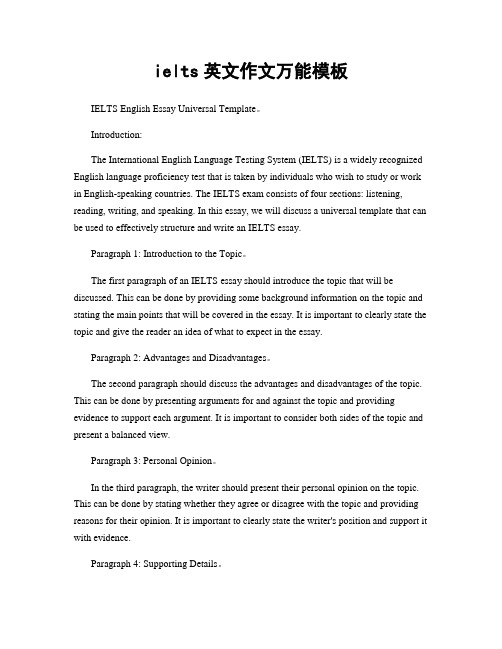
ielts英文作文万能模板IELTS English Essay Universal Template。
Introduction:The International English Language Testing System (IELTS) is a widely recognized English language proficiency test that is taken by individuals who wish to study or work in English-speaking countries. The IELTS exam consists of four sections: listening, reading, writing, and speaking. In this essay, we will discuss a universal template that can be used to effectively structure and write an IELTS essay.Paragraph 1: Introduction to the Topic。
The first paragraph of an IELTS essay should introduce the topic that will be discussed. This can be done by providing some background information on the topic and stating the main points that will be covered in the essay. It is important to clearly state the topic and give the reader an idea of what to expect in the essay.Paragraph 2: Advantages and Disadvantages。
雅思写作模板
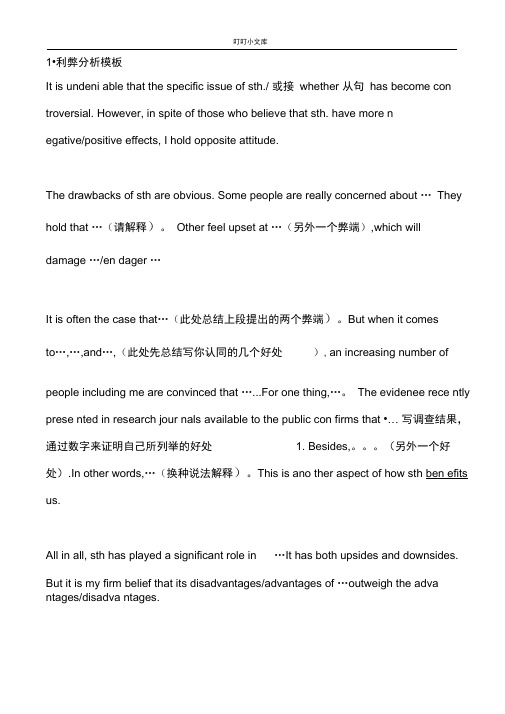
It is undeni able that the specific issue of sth./ 或接whether 从句has become con troversial. However, in spite of those who believe that sth. have more negative/positive effects, I hold opposite attitude.The drawbacks of sth are obvious. Some people are really concerned about … They hold that …(请解释)。
Other feel upset at …(另外一个弊端),which willdamage …/en dager …It is often the case that…(此处总结上段提出的两个弊端)。
But when it comes to…,…,and…,(此处先总结写你认同的几个好处),an increasing number of people including me are convinced that …...For one thing,…。
The evidenee rece ntly prese nted in research jour nals available to the public con firms that •… 写调查结果,通过数字来证明自己所列举的好处 1. Besides,。
(另外一个好处).In other words,…(换种说法解释)。
This is ano ther aspect of how sth ben efits us.All in all, sth has played a significant role in …It has both upsides and downsides. But it is my firm belief that its disadvantages/advantages of …outweigh the adva ntages/disadva ntages.There is no denying that the specific issue of sth./ 或接whether 从句has become con troversial. However, in spite of those who are aga inst/ for …,I approve wholeheartedly of/ 或I strongly object to the idea that …Those who hold negative/ positive attitude towards •…believe that •…may exert adverse/ sig ni fica nt effect on us. …is always top of the list of their argume nt. For example,…(请用举例子的方法解释).Besides, those critics/ advocates also claim that … (此处写第二个原因)for the reason that ….It is often the case that…(此处总结上段反方提出的几个观点)。
雅思写作范文(2020年7月整理).pdf

(七分范文)Some people believe that studying at university or college is the best route to a successful career, while others believe that it is better to get a job straight after school.Discuss both views and give your opinion.When they finish school, teenagers face the dilemma that whether to get a job or continue their education. While there are some benefits to getting a job straight after school, I would argue that it is better to go to college or university.The option to start work straight after school is attractive for several reasons. Many young people want to start earning money as soon as possible. In this way, they can become independent, and they will be able to afford their own house or start a family. In terms of their career,young people who decide to find work, rather than continue their studies, may progress more quickly. They will have the chance to gain real experience and learn practical skills related to their chosen profession. This may lead to promotions and a successful career.On the other hand, I believe that it is more beneficial for students to continue their studies. Firstly, academic qualifications are required in many professions. For example, it is impossible to become a doctor, teacher or lawyer without having the relevant degree. As a result,university graduates have access to more and better job opportunities, and they tend to earn higher salaries than those with fewer qualifications. Secondly, the job market is becoming increasingly competitive, and sometimes there are hundreds of applicants for one position in a company. Young people who do not have qualifications from a university or college will not be able to compete.For the reasons mentioned above, it seems to me that students are more likely to be successful in their careers if they continue their studies beyond school level.以上就是这篇雅思写作7分范文的全部内容,字数足够。
雅思真题作文范文模板

雅思真题作文范文模板Introduction:In recent years, the issue of environmental protection has become increasingly prominent. It is widely believed that the government should take more responsibility for protecting the environment, while others argue that individuals should be the ones to take action. In this essay, I will discuss both sides of the argument and provide my own perspective on this issue.Government Responsibility:On the one hand, many people believe that the government should take more responsibility for protecting the environment. This is because the government has the power and resources to implement large-scale environmental protection measures. For example, the government can pass laws and regulations to limit industrial pollution, protect natural habitats, and promote sustainable development. Furthermore, the government can invest in renewable energy sources and provide incentives for businesses to reduce their carbon footprint. By taking these actions, the government can make a significant impact on the environment and ensure a sustainable future for the planet.Individual Responsibility:On the other hand, some argue that individuals should be the ones to take action to protect the environment. They believe that small, everyday actions can add up to make a big difference. For example, individuals can reduce their energy consumption, recycle their waste, and choose sustainable products. By making these choices, individuals can reduce their own environmental impact and set an example for others to follow. Furthermore, individuals can participate in community clean-up events, plant trees, and support environmental organizations. By taking these actions, individuals can contribute to a cleaner, healthier planet.My Perspective:In my opinion, both the government and individuals have a role to play in protecting the environment. The government should take the lead in implementing large-scale environmental protection measures, such as investing in renewable energy and enacting strict regulations on pollution. At the same time, individuals should take responsibility for their own environmental impact by making sustainable choices in their daily lives. By working together, the government and individuals can create a more sustainable future for the planet.Conclusion:In conclusion, the issue of environmental protection is complex, and both the government and individuals have a role to play. It is essential for the government to take the lead in implementing large-scale environmental protection measures, while individuals should also take responsibility for their own environmental impact. By working together, we can create a more sustainable future for the planet.。
